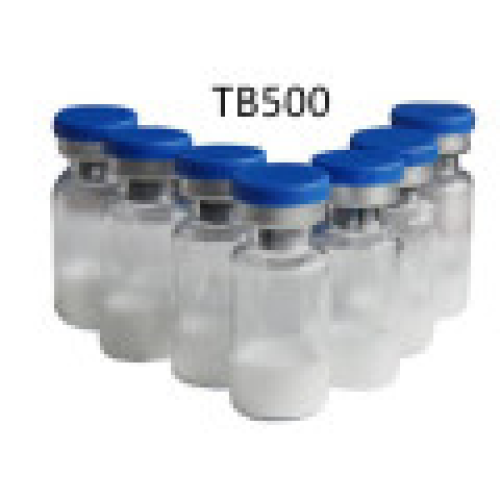The compound on which the fluorescent label is dependent is called a fluorescent substance. A fluorescent substance refers to a compound having a chemical structure of a conjugated double bond system. When irradiated with ultraviolet light or blue-violet light, it can be excited to an excited state, and when it is restored from the excited state, it emits fluorescence. Fluorescent labeling technology refers to the use of a fluorescent substance to covalently bind or physically adsorb on a certain group of a molecule to be studied, and to use its fluorescent properties to provide information on the object to be studied. Fluorescently labeled non-radioactive contamination, easy to operate, etc., make fluorescent labels widely used in many research fields.
Fluorescent labeling substances are also widely used in the fields of functional research and drug screening of proteins. The use of fluorescently labeled polypeptides to detect the activity of a target protein and its development of high-throughput activity screening methods for drug screening and drug development of disease-targeted proteins (eg, various kinases, phosphatases, peptidases) Wait). Therefore, the fluorescent modification of the polypeptide is also an important content in the field of polypeptide synthesis.
Here are some commonly used peptide-modified fluorescent substances:
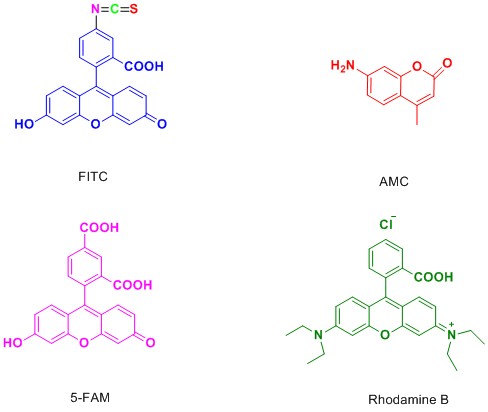
Below are the excitation light wavelengths and emission wavelengths of some fluorescent substances.

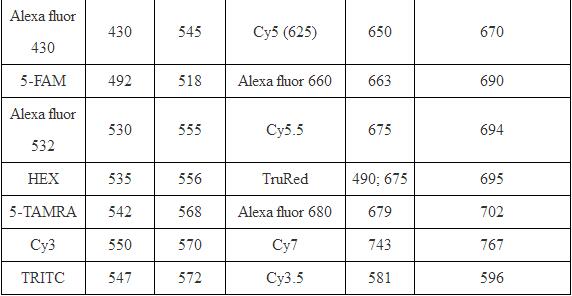
1. FITC modified fluorescein isothiocyanate (FITC) has relatively high activity. Generally speaking, it is easier to introduce this fluorophore in the solid phase synthesis process than other fluorescein, and it is not needed during the reaction. Add an activating reagent.
The FITC-modified peptides synthesized by our company usually have two main forms:
(1) APTC is inserted at the end of the entire peptide chain, and a molecule of Acp (6-aminocaproic acid), also referred to as an alkyl spacer, is inserted before FITC. In the reaction, FITC reacts with the exposed -NH2 on the peptide chain. The access of Acp provides a linear space of six carbons, which greatly reduces the steric hindrance of the reaction, improves the reaction efficiency, and reduces the reaction difficulty. Secondly, FITC also reacts with -SH and side chain -NH2 in the structure of the polypeptide. The addition of Acp also reduces the possibility of this side reaction. In addition, when the polypeptide is cleaved under acidic environmental conditions, the polypeptide that is inserted into the FITC at the N-terminus needs to undergo cyclization to form fluorescein, which is usually accompanied by the excision of the last amino acid, and the access of the alkyl spacer Acp. This avoids this happening.
(2) A certain Lys side of the entire peptide is linked into FITC, and the Lys side chain is a four-carbon linear alkyl group having a terminal -NH2, which directly acts to reduce steric hindrance. This modification allows for flexible FITC modification anywhere in the entire peptide, not just the ends.
The two forms of FITC modified polypeptides we use have the advantages of simple operation, high success rate, easy separation and purification.
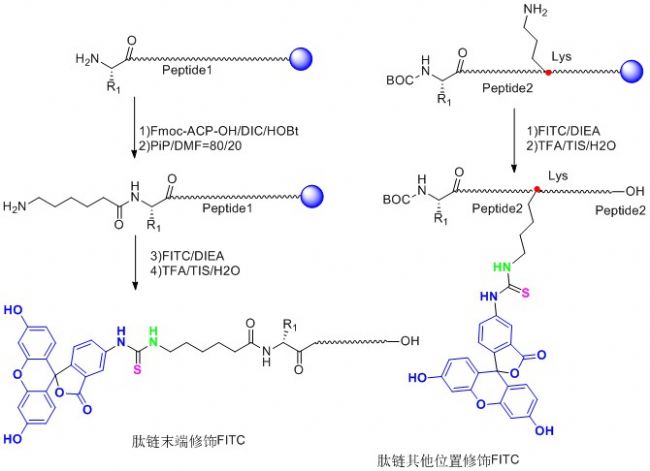
2. AMC modification
7-Amino-4-methylcoumarin (AMC) is a widely used fluorescent labeling reagent, for example, trace measurement of enzymes, identification of enzymes, preparation of laser dyes, etc. The coumarin-modified ubiquitin molecule is also an important probe for studying the process of protein ubiquitination.
Unlike other fluorescent dyes, AMC-modified polypeptide molecules are carried out from the C-terminus: (1) AMC reacts with the first amino acid at the C-terminus of the peptide chain; (2) Solid phase synthesizes the entire peptide chain (starting with the second amino acid) And retaining the side chain protecting group and the last amino protecting group of the entire peptide chain; (3) liquid phase condensing AA-AMC with a fully protected peptide chain; (4) excising the protecting group to complete modification of the peptide chain.
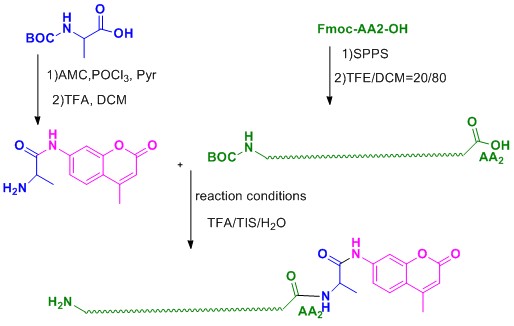
The peptidomimetic provides various modified high quality polypeptides such as 5(6)-FAM, FITC, CY5, Rhodamine B, PNA, EDNAS/dabcyl, Biotin. National peptide organisms have mature fluorescent-labeled peptide technology, excellent purification production process, custom fluorescent modified peptides, and national peptide organisms are trustworthy brands.
success case:
The sequence Cy5-betaA-YNDEDPEKEKRIKELELLLMSTENELKGQQAL, CY5 was modified.
HPLC analysis:

MS analysis:
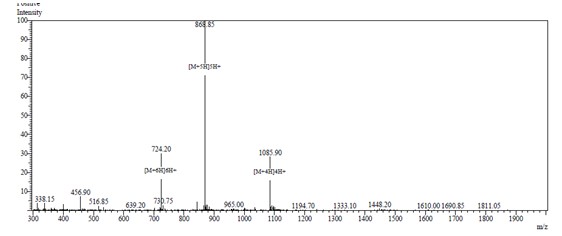






 1. FITC modified fluorescein isothiocyanate (FITC) has relatively high activity. Generally speaking, it is easier to introduce this fluorophore in the solid phase synthesis process than other fluorescein, and it is not needed during the reaction. Add an activating reagent.
1. FITC modified fluorescein isothiocyanate (FITC) has relatively high activity. Generally speaking, it is easier to introduce this fluorophore in the solid phase synthesis process than other fluorescein, and it is not needed during the reaction. Add an activating reagent.  2. AMC modification
2. AMC modification 


